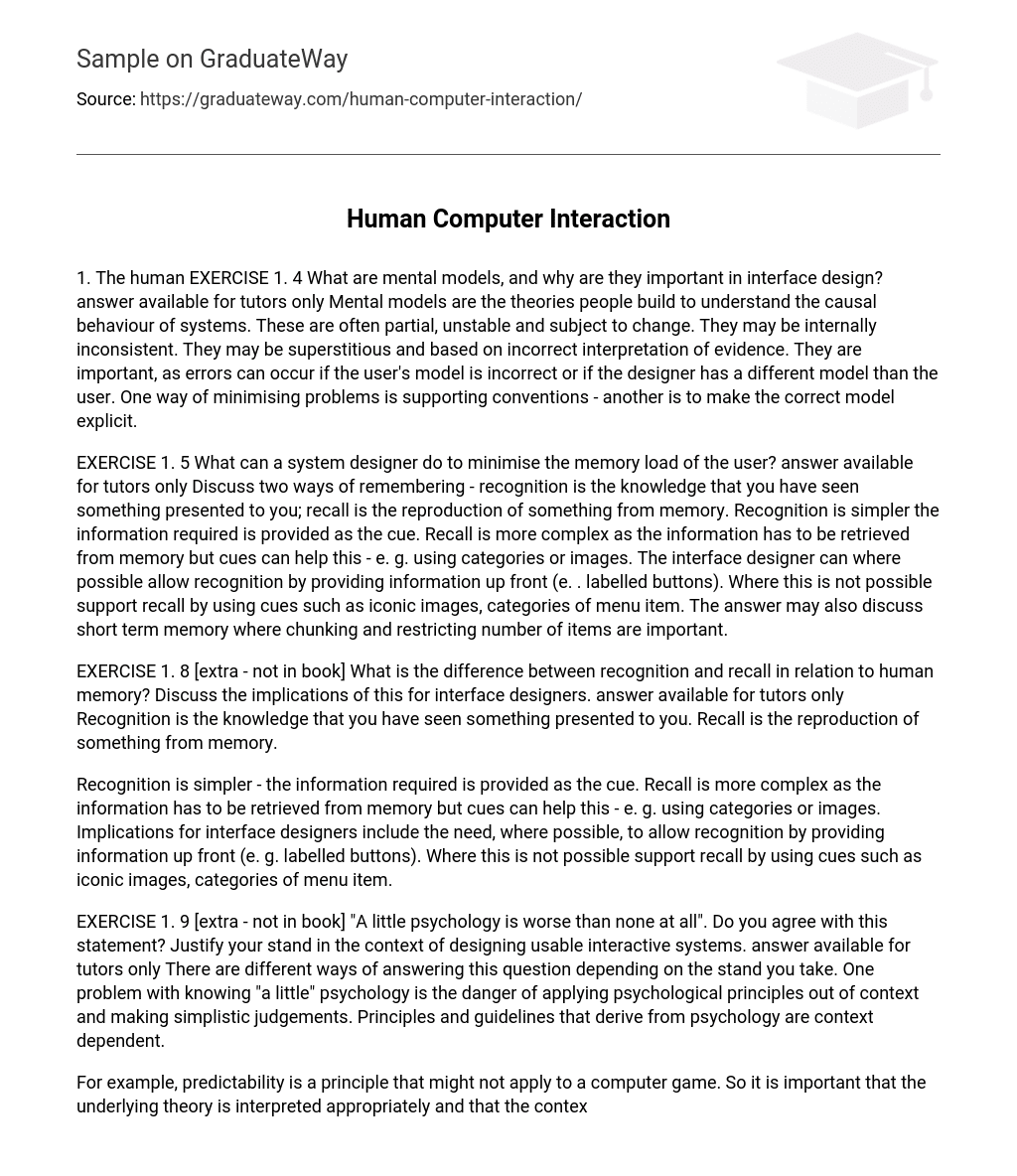EXERCISE 1
What are mental models, and why are they important in interface design? answer available for tutors only Mental models are the theories people build to understand the causal behaviour of systems. These are often partial, unstable and subject to change. They may be internally inconsistent. They may be superstitious and based on incorrect interpretation of evidence. They are important, as errors can occur if the user’s model is incorrect or if the designer has a different model than the user. One way of minimising problems is supporting conventions – another is to make the correct model explicit.
EXERCISE 2
What can a system designer do to minimise the memory load of the user? answer available for tutors only Discuss two ways of remembering – recognition is the knowledge that you have seen something presented to you; recall is the reproduction of something from memory. Recognition is simpler the information required is provided as the cue. Recall is more complex as the information has to be retrieved from memory but cues can help this – e. g. using categories or images.
The interface designer can where possible allow recognition by providing information up front (e. . labelled buttons). Where this is not possible support recall by using cues such as iconic images, categories of menu item. The answer may also discuss short term memory where chunking and restricting number of items are important.
EXERCISE 3
What is the difference between recognition and recall in relation to human memory? Discuss the implications of this for interface designers. answer available for tutors only Recognition is the knowledge that you have seen something presented to you. Recall is the reproduction of something from memory.
Recognition is simpler – the information required is provided as the cue. Recall is more complex as the information has to be retrieved from memory but cues can help this – e. g. using categories or images. Implications for interface designers include the need, where possible, to allow recognition by providing information up front (e. g. labelled buttons). Where this is not possible support recall by using cues such as iconic images, categories of menu item.
EXERCISE 4
“A little psychology is worse than none at all”. Do you agree with this statement? Justify your stand in the context of designing usable interactive systems. answer available for tutors only There are different ways of answering this question depending on the stand you take. One problem with knowing “a little” psychology is the danger of applying psychological principles out of context and making simplistic judgements. Principles and guidelines that derive from psychology are context dependent.
For example, predictability is a principle that might not apply to a computer game. So it is important that the underlying theory is interpreted appropriately and that the context in which the rule is applied is comparable to that of the theory. An example of misuse of psychology is in the application of the 7+/- 2 short term memory limit to menu design. Menus support recognition by presenting the options to the user – this is not a task that relies on short term memory. Therefore the oft-heard recommendation to limit menu items to 7+/- 2 is a misapplication of psychology. Try to find more examples of well and badly applied psychology for yourself.
EXERCISE 5
What is the difference between a slip and a conceptual error? How might a designer minimise the occurrence of both among users of a system? answer available for tutors only A slip is an error that occurs when the context of skilled behaviour is changed. A conceptual error occurs due to lack of understanding on the part of the user. This may be a result of an inadequate or incorrect mental model. Answer should discuss ways of supporting mental models – e. g. ransferring user’s knowledge from other domains, using familiar objects, maintaining consistency between platforms, providing feedback, etc. Slips can be avoided by ensuring consistency, taking account of stress in skilled operation, etc.
EXERCISE 6
How might you use the notion of reward in interface design to increase the positive emotional response of users? Can you find any examples of this? answer available for tutors only Reward is essentially positive reinforcement of desired or good behaviour. This could be through providing explicit praise (used frequently n educational systems when a correct answer is given) or through more implicit elements that engage or entertain the user.
Novelty, social interaction, feedback and surprise are all potentially rewarding to the user. For example, seeing a direct relationship between action and effect (feedback) can be rewarding. However care needs to be taken because each of these things can backfire and become irritating if not used properly. Example of this is the Microsoft Office paperclip , which attempts to motivate users by making getting help a novel social interaction, was actually irritating to users and was eventually dropped. e original paper spreadsheet has been.





